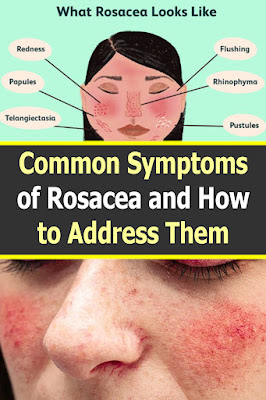Common Symptoms of Rosacea and How to Address Them
Rosacea is a chronic skin condition characterized by redness, visible blood vessels, and sometimes small, red, pus-filled bumps on the face. While there is no cure for rosacea, understanding its symptoms and adopting certain skincare practices can help manage and alleviate the condition. In this article, we'll explore the common symptoms of rosacea and provide practical tips on how to address them.
1. Persistent Facial Redness:
- Symptom: The most noticeable sign of rosacea is persistent facial redness, often resembling a flush or blush that doesn't subside.
- Addressing It: Use a gentle, fragrance-free moisturizer to soothe the skin. Green-tinted color-correcting makeup can help neutralize redness.
2. Visible Blood Vessels (Telangiectasia):
- Symptom: Small, dilated blood vessels near the surface of the skin become visible.
- Addressing It: Consult with a dermatologist about laser therapy, which can effectively reduce the appearance of visible blood vessels.
3. Acne-Like Bumps and Pustules:
- Symptom: Red, pus-filled bumps that may be mistaken for acne.
- Addressing It: Avoid harsh skincare products. Use gentle, non-comedogenic cleansers and consult a dermatologist for appropriate prescription medications.
4. Eye Irritation (Ocular Rosacea):
- Symptom: Watery or bloodshot eyes, a gritty feeling, or light sensitivity.
- Addressing It: Practice good eye hygiene, use artificial tears, and seek advice from an eye doctor for specialized treatments.
5. Flushing and Blushing Easily:
- Symptom: A heightened sensitivity to temperature changes, stress, or spicy foods leading to increased flushing.
- Addressing It: Identify triggers and minimize exposure. Consider stress-reduction techniques and maintain a consistent skincare routine.
6. Dry, Irritated Skin:
- Symptom: Rosacea-prone skin can often be dry, rough, and prone to irritation.
- Addressing It: Use a mild, hydrating cleanser and a hypoallergenic moisturizer to maintain skin barrier function.
7. Swelling and Thickening of the Skin:
- Symptom: In some cases, the skin may thicken, especially around the nose.
- Addressing It: Topical medications prescribed by a dermatologist can help manage thickened skin. Laser therapy may also be considered.
8. Rhinophyma (Enlarged Nose):
- Symptom: In rare cases, rosacea can lead to the enlargement of the nose.
- Addressing It: Consult a dermatologist for appropriate medical interventions, which may include medications or surgery.
Practical Tips for Managing Rosacea:
Gentle Skincare Routine:
Use mild, fragrance-free skincare products to avoid irritation.
Sun Protection:
Wear broad-spectrum sunscreen daily to protect the skin from UV rays.
Identify Triggers:
Keep a diary to identify and avoid triggers such as spicy foods, alcohol, or extreme temperatures.
Cooling Measures:
Use cool compresses to alleviate flushing and redness.
Prescription Medications:
Consult a dermatologist for prescription medications tailored to your specific symptoms.
Lifestyle Modifications:
Manage stress through relaxation techniques and exercise.
Professional Treatments:
Explore dermatological procedures such as laser therapy or IPL (intense pulsed light) under the guidance of a dermatologist.
Remember, the key to managing rosacea is consistency in skincare practices and seeking professional advice for personalized treatment plans. While there is no cure, adopting a proactive approach can significantly improve the quality of life for individuals with rosacea.
